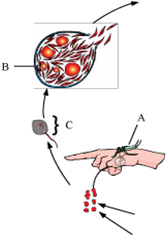 Short Answer Type
Short Answer Type(a) Why are the fruit juices bought from market clearer as compared to those made at home?
(b) Name the bioactive molecules produced by Trichoderma polysporum and Monascus purpureus.
 Long Answer Type
Long Answer TypeDescribe the asexual and sexual phases of life cycle of Plasmodium that causes malaria in humans.
 Short Answer Type
Short Answer Type(a) Highlight the role of thymus as a lymphoid organ.
(b) Name the cells that are released from the above-mentioned gland. Mention how they help in immunity.Name of parasite the causes filariasis in humans. Mention its two diagnostic symptoms. How is this transmitted to others?
Study a part of the life cycle of malarial parasite given below. Answer the questions that follow: 
(a) Mention the roles of A in the life cycle of the malarial parasite.
(b) Name the event C and the organ where this event occurs.
(c) Identify the organ B and name the cells being released from it.(a) A in the image represents the female mosquito. The female mosquito takes up the gametocytes of the malarial parasite along with the blood meal when it bites an infected person.
(b) The event 'C' is the fertilization stage and it takes place in the intestine of the mosquito.
(c) The organ 'B' is the salivary gland of the mosquito and the sporozoites escape out of the mosquito's salivary gland.Write the scientific names of the causal organisms of elephantiasis and ringworm in humans. Mention the body parts affected by them.
